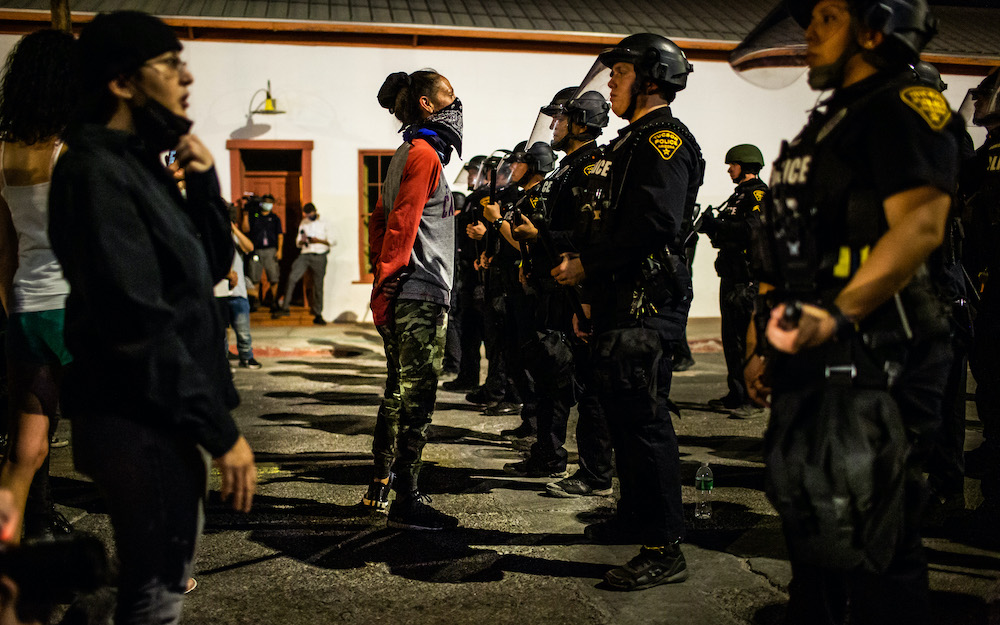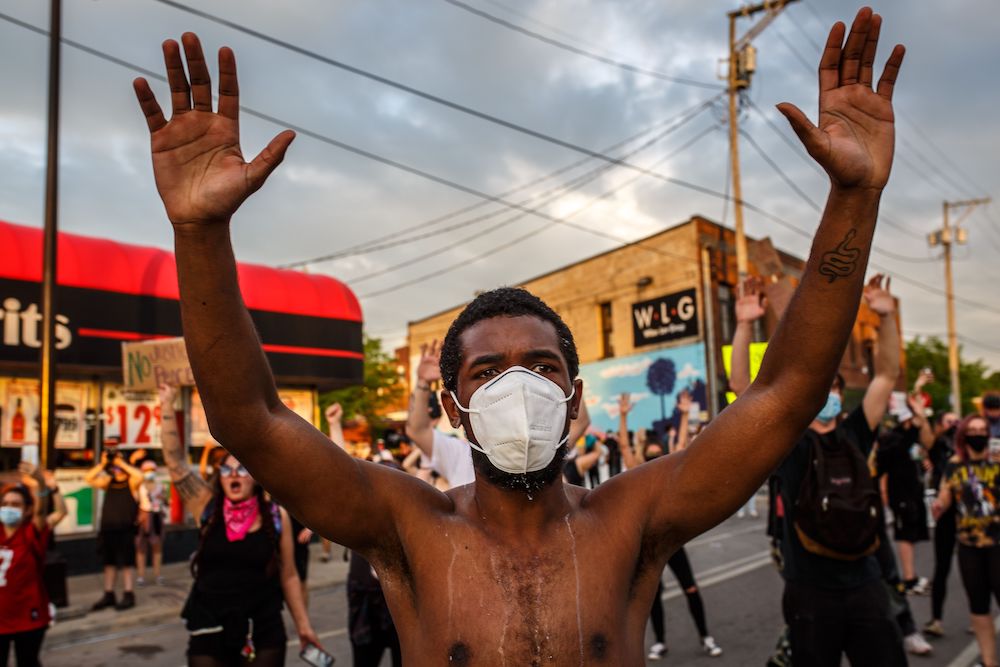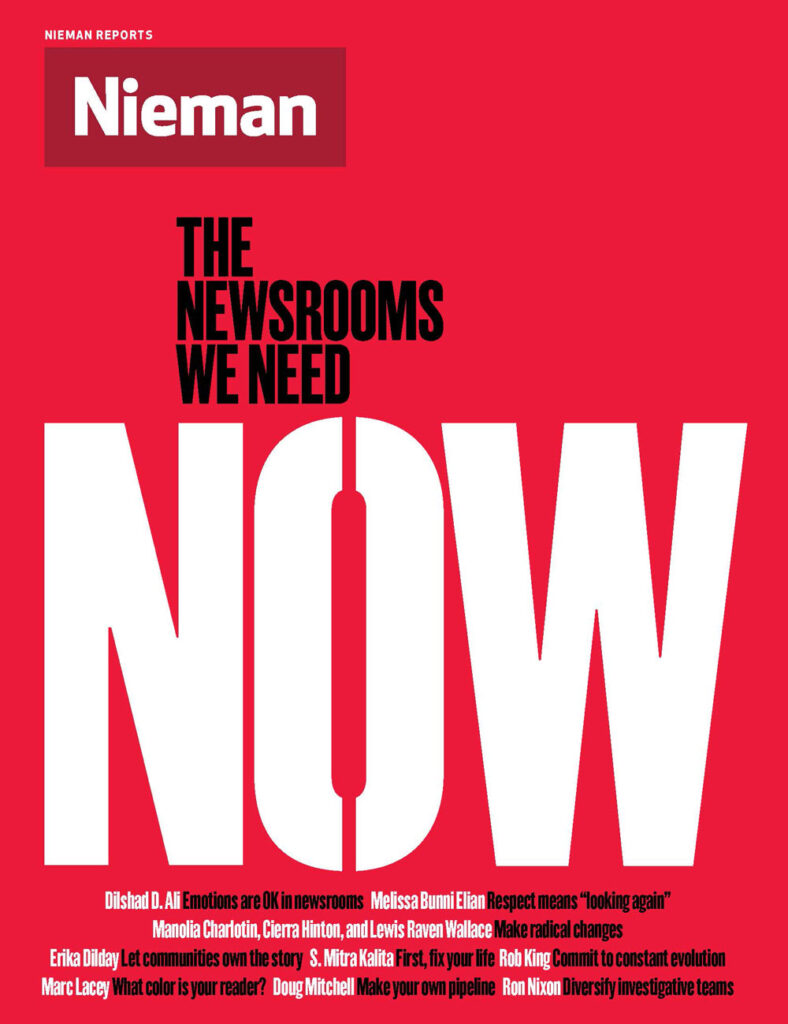American journalists are chronicling a nation in turmoil. The strife centers around inequality and is fueled by our inability to understand each other. We are a country of factions that has not figured out how to work together for an equitable society.
At the root of this problem is race.
We stand at another pivotal moment of our national identity. Once again, people of color, particularly Black people, have been driven to act by the constant assault of systemic, brutal, confrontational racism that threatens our present, our future, and our very survival. The Black Lives Matter action may be new, but the frustration, call to action, and anger that action represents are not. Throughout our turbulent history, these issues have been consistently covered by journalists, but we must recognize that journalism, as it is currently practiced, contributes to the problem.
Without an approach to reporting that is observational instead of narrational, and that recognizes each journalist’s part in and relationship to the story, we do a disservice, particularly to those whom we don’t immediately understand and can’t accurately represent. For the most part, this disservice has been done to communities of color, immigrants, and those of lower socioeconomic status.
Journalists have created and enabled a system of news and media that deems terms like “ethics,” “journalism,” and “truth” unassailable, depending on the speaker or forum. The codes of ethics and standards of practice we put forth in the West often differ greatly from those adopted by journalists in other parts of the world. But we tend to think that they should learn from us and not that we should learn from them. This means our norms are codified by a small, homogeneous group that informal but firm consensus has decided are the gatekeepers of the fourth estate. This has led to huge blind spots in how and what we cover.
What needs to change is the journalist’s role within a story
What needs to change is the journalist’s role within a story. I believe our role is facilitator instead of interpreter, catalyst instead of judge. The narrative that we see immediately may not be the real one. We always have to ask ourselves, Who am I to tell this story? We have to accept that by telling it, we take a role. We inject bias and subjectivity, and we must recognize that at all times. Our belief in our ability to be objective is our own hubris.
Our goal must be to present the entire picture, to see people — no matter their circumstances — from many angles. If we don’t, we isolate our audiences from our subjects instead of bringing them closer.
The only way we can report the “truth” is by allowing people to share their stories, by asking our audiences to meet people where they are, and to absorb information, ideas, and voices that take them out of their comfort zones. We must also ensure that we have the right people in the room to help make decisions about how those stories are shared, or we run the risk of perpetuating the same problems we are trying to solve.
When we are not careful about not just who but how others are represented, the effect can be damaging. In 2016, The New York Times attempted to give its readers insight into the lives of Black Americans by sharing different stories written by African Americans about their reality. These first-person narratives were exactly what should be shared. But the article missed the mark. Why? Because the subhead of the article was, “What do people fail to understand about the lives of black Americans?”
The armchair white reader probably wouldn’t notice the problem, and this is what makes bias and hubris so dangerous. For some reason, the idea of “people” in this subhead excludes Black Americans. There is no qualifier. It doesn’t say, “What do WHITE people fail to understand…” or “What do NON-BLACK people fail to understand…” We are the other, and the Times reinforced that idea.
A more recent example comes from a column about Andrew Yang and the “Yang Gang” that also appeared in The New York Times. The columnist represented the Yang Gang as follows: “That night, the Yang Gang, as the candidate’s fans proudly call themselves, was a happy crowd of gamers, Asians, former goth girls, Burning Man enthusiasts, sci-fi geeks, students, coders and stoners.” At some point, the embarrassing use of “Asians” as separate from all the others was silently removed from the column, but this was after publication.
Though these examples are from the Times, many major outlets experience this type of blindness, a blindness called out by the Kerner Commission Report back in 1968.
In 1967 America was in the middle of a civil war for civil rights. Frightened and frustrated, the U.S. government formed the National Advisory Commission on Civil Disorders, led by Governor Otto Kerner Jr. of Illinois. In February of 1968, weeks before Martin Luther King Jr.’s assassination, it issued the Kerner Commission Report, which recognized the issues that were brewing: “What white Americans have never fully understood — but what the Negro can never forget — is that white society is deeply implicated in the ghetto. White institutions created it, white institutions maintain it, and white society condones it.”
The language may be anachronistic, but the intent is clear. People of color — or more expansively, the “other” — must be front and center in the coverage of people of color and a part of any societal conversation. The report advocated changes in the news media around three major ideas: recruit and advance qualified people of color into journalism and journalism management; create opportunities to train and educate journalists in the coverage of the “other”; and create media vehicles that recognize these groups exist and are active, important members of the American community.

After Kerner, very little was done by those in power to take action on any of the report’s conclusions. One notable and unique case was when the FCC was ordered in 1969 to revoke the operating license of a television station in Mississippi. WLBT-TV in Jackson had its license rescinded for failing to serve the public interest; this failure basically amounted to overtly racist practices, including blocking speeches by liberal politicians and focusing on the faces of protesters, which made them potential targets of law enforcement. In response, WLBT was forced to transfer ownership to a Black group, and that group hired the nation’s first Black general manager of a television station in the United States in 1972.
That general manager was my father.
I grew up in Mississippi, transplanted there from Boston, when my father, William H. Dilday Jr., a personnel manager, took the leap and moved his entire family to Jackson to start work at WLBT-TV. My father and mother both came from large close-knit Boston families, which like many Black Bostonians were sprinkled throughout the southern part of the city in neighborhoods including the South End, Jamaica Plain, Roxbury, and Dorchester. When we moved to Mississippi, we knew no one and had never been south of Washington, D.C. Many of our family and friends thought the reverse migration was dangerous and crazy. For my father, the move was his opportunity to make a difference, and he did not back down from a challenge. The rest of us were just along for the ride.
What the ride taught me was that journalism was an extremely powerful tool and that without varied points of view and the ability of diverse voices to help shape the narrative, we are in danger of not just missing the story but doing harm.
I grew up at the station, pretending to broadcast from the news desk, selling Girl Scout cookies, and absorbing that some people thought my father was a hero and others saw him as a troublemaker and villain. One of the most memorable events of my youth was when, in 1980, my father refused to air the miniseries “Beulah Land,” which depicted life on a plantation, on WLBT. The series was shot in Mississippi, and many local people were featured as extras in the production. However, it was overwhelmingly panned and also boycotted by the NAACP for “what they say is an effort to make Americans believe blacks enjoyed life on the plantation,” according to a UPI review at the time. The only other NBC station in the country that didn’t carry it was WBAL-TV in Baltimore.
I remember the anger that was directed toward my father. The Mississippi Film Commission released a statement against WLBT, and even Black actors threatened to boycott the station. I also remember my father never wavering, even though racial tensions were already high in the city and both the NAACP and the Ku Klux Klan held demonstrations that weekend over this and other incidents.
Without varied points of view and the ability of diverse voices to help shape the narrative, we are in danger of not just missing the story but doing harm
As a Black station manager, he knew the importance of the narrative. This narrative was false and, even worse, damaging. The Washington Post summed it up: “‘Beulah Land’ is not suitable for human habitation. The first two chapters of this six-hour NBC mini-series about a Southern plantation are so clatteringly, clumsily awful they’re pretty funny, but in the third chapter it turns ugly and hateful and leaves one feeling nauseated.”
Over the course of his time at WLBT, my father continued to make decisions that changed the face of the station. He hired Black people and women for both on-air and behind-the-scenes positions at a level never before seen in Mississippi, and he still brought the station from loss to profitability.
The norms my father helped break were set by small, elite groups that wrote journalistic codes at several key points in the nation’s history. These groups were overwhelmingly, and at times exclusively, white, privileged, and male.
These norms led us to believe that in order to speak authoritatively, speakers must sound like a white man from the mid-Atlantic, even when the speaker is anything but. People from other countries couldn’t speak with strong accents — unless they were British aristocrats. Black women had to have their hair styled in a manner that did not look too “ethnic.” And words from another language could never pop into the conversation — unless, of course, they were French.
Journalists can’t pretend to know the other or how to represent the other. So, the new norm has to be: “Others” must tell their own stories.
In Sarah Burns and David McMahon’s “East Lake Meadows: A Public Housing Story” documentary (PBS, 2020), there are experts and pundits who speak about the history of the housing development and its demise. But the story is overwhelmingly told by the residents who lived there. They directly share opinions, experiences, and viewpoints that allow the audience to understand firsthand what they experienced. McMahon and Burns, both white, knew that the story was theirs to guide but not to tell. The result is beautiful, authentic, and real.
Journalism needs to let people own their own narratives.
Too often, particularly in marginalized communities, journalists create POCporn, people of color porn. Like poverty porn and other types of superficial coverage, POCporn focuses on the shock value of situations and the “otherness” of marginalized communities, allowing armchair middle-class audiences to reinforce the stereotypes they already have of “those people” and “those places.” These stories may engender sympathy, but they don’t foster understanding.
A Netflix documentary, “Immigration Nation,” and a piece produced and reported by people of color, from Latino USA, offer a case in point.
The Netflix series starts with ICE executing a warrant, knocking on a door, politely forcing their way into a home and detaining a despondent man. We don’t know who he is; the only name we have is “Anna,” the woman who opens the door. There is mention of a baby, but the fact that this is a family is barely distinguishable. Later in the documentary, there are also the requisite “good” immigrants, who can prove their value to this country and therefore deserve not to be deported.
Latino USA’s story focuses on the Mississippi ICE raids in 2019 and is told by people of color. The story starts with a woman and her daughter and identifies their native tongue as the Mayan language Mam. As the report begins, we are introduced to the little girl, who speaks Mam, Spanish, and English and, at 12, is prepared to stay in this country if her mother, who wears an ankle bracelet, is deported. The basics of their story are translated, but throughout you hear the mother and daughter speaking in their own voices.
So, how do we know when we are hitting our blind spots? How do we practice journalism with humility and responsibly?
The simple answer to all of these questions is, by helping people tell their own stories.
We must incorporate, in our newsrooms and in our management structures, people who are the “other” and allow them to speak up when they see that we are on the wrong path. I have a colleague who is also a Black woman who has been in journalism for more than 30 years. Her method of dealing with majority blind spots in news coverage is to decide, “Is this the battle I will pick this week? Because I won’t be listened to twice.”
We need to listen more than twice. We need people of color to feel that they can speak to these issues and educate their peers without feeling that it will be a “battle.”
As a journalist and supervisor of journalism, my trajectory has been shaped by experience, frustration, and ultimately a deep sense of responsibility to help get things right. I’ve learned from mentors, POC and white, how to be a better journalist.
Journalists need to talk less, listen more, and realize that reporting does not mean digesting for your audience
Change will involve a level of humility from majority journalists and tolerance on the part of people of color. Yes, we are angry, but we need to use our anger to form coalitions and create large-scale change. We need not to spend our time telling people in power what they have done wrong; we need to tell them what they need to do to make things right.
Too often, we spout a list of grievances instead of actionable solutions. The National Association of Black Journalists focuses on solutions by not only calling out racism in journalism, but also producing an online style guide that sets standards on how to talk about communities of color.
As a profession, we need to refocus what we call “ethics.” Our current codes of ethics focus on objectivity and honesty, but don’t recognize that journalists are people with experiences, ideas, and points of view. A good start is to look at the codes of ethics for other countries.
The code of ethics for Namibian media includes the sentence: “While a journalist is entitled to have his own political and other opinions, the newspaper or broadcaster must recognize and give due consideration to the opinions of others in the community.” And the Press Council of India includes the following in its code: “The media shall make every possible effort to build bridges of co-operation, friendly relations and better understanding between India and foreign States.”
While these principles may not fit specifically within our ideas of what journalism should be, the position of the journalist in society can and should be examined through different lenses.
At the very least, we have to get our audiences out of their comfort zones and let them hear accents and different modes of speech and even a few words in another language.
Stop the production of POCporn by making sure that editors and reporters who understand the particular landscape are contributing to the shaping of stories. Veteran journalists have to learn to understand where and how their limitations will hurt a story. Let people of color take the lead when appropriate. Having one or two people on staff isn’t enough to address systemic problems.
Actively engage people of color on all levels and use community advocates and other people who work daily with marginalized groups to shape how things are covered and to identify what is missing. Don’t assume that one person of color has the answer. We are different people with different ideas and different opinions on what is needed. Listen, learn, and assume that the answers have the same complexity as the problem.
Most importantly, remember that journalists need to talk less, listen more, and realize that reporting does not mean digesting for your audience. Give audiences a chance to do it themselves. Our future depends on it.
Erika Dilday is chief executive officer and executive director at The Futuro Media Group.




